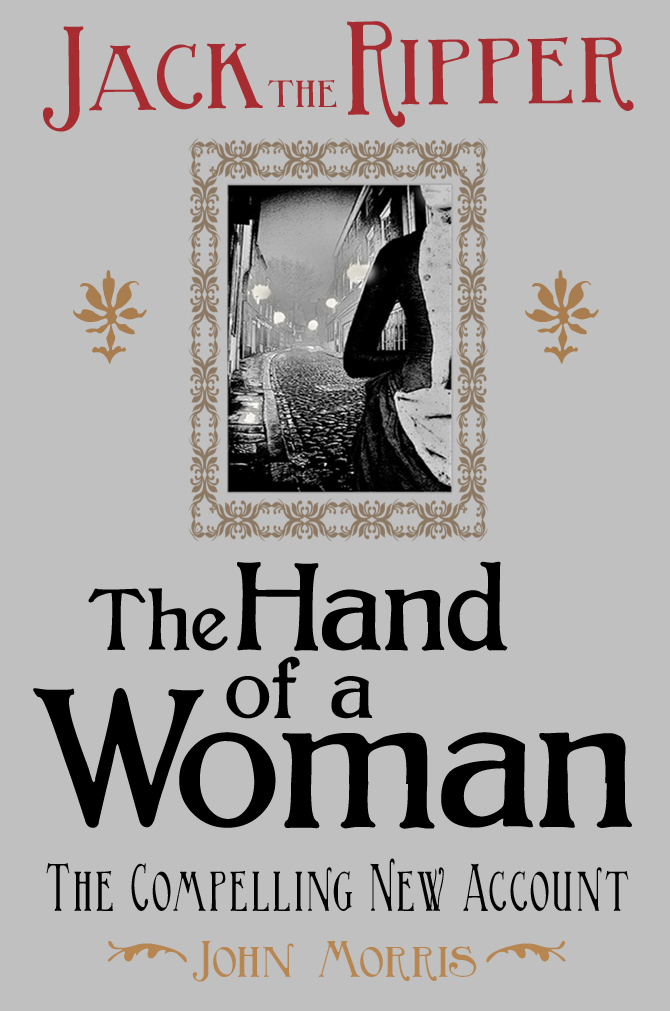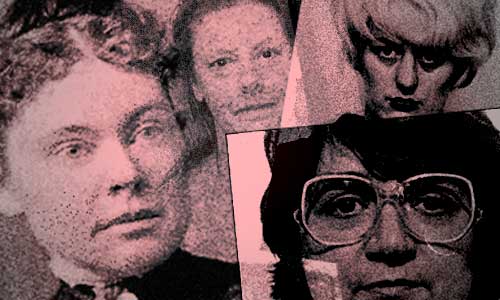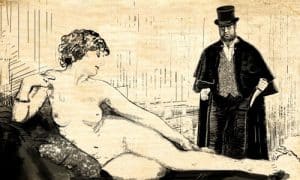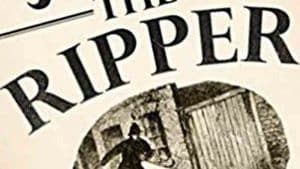Guest writer JOHN MORRIS, author of Jack the Ripper: The Hand of a Woman, argues the reason we’re never found the Whitechapel murderer is because Jack the Ripper was really a Jill …
During a 10-week period in the autumn of 1888, the bodies of five women, all of them prostitutes, were discovered in London’s East End district of Whitechapel.
Despite an intensive police hunt for the murderer, no one was ever caught, nor was there an obvious motive.
Three weeks after the murder of the second victim, Annie Chapman, a letter was received by Scotland Yard claiming responsibility for the crimes.
It appeared to have been written in blood, and was signed “Jack the Ripper.”
It was published in the newspapers in an unsuccessful attempt to identify its author, but the name impacted deeply upon the minds of the public, and, to this day,
it is almost impossible to even consider that the murderer could have been anyone other than a man.
READ: Jill the Ripper? 5 women accused of being Jack
During the course of my research for Jack the Ripper: The Hand of a Woman, I considered many thousands of documents including police witness statements, medical reports and extensive inquest testimony, but there was nothing I could find anywhere that showed that the murderer must have been a man.
There are numerous clues scattered throughout the crimes which, taken individually, may mean little, but when grouped together, a strong case for a woman murderer begins to emerge:
- None of the victims were raped or sexually assaulted;
- Three personal items were ‘neatly laid out’ at the feet of the second victim, Annie Chapman, in a ‘typically feminine manner’;
- Three scratches, perhaps the marks of long fingernails, were discovered on the side of Chapman’s neck;
- Three small buttons from a woman’s boots were found in clotted blood by the neck of the fourth victim, Catherine Eddowes – when she wore men’s laced-up boots;
- The remnants of womens clothing, a cape, skirt and a hat found amongst the ashes in Mary Kelly’s fireplace, clothes which no one had ever seen Kelly wearing – and she did not even own a hat;
- An unexplained sighting by a reliable witness of a woman she believed to be Mary Kelly, several hours after Kelly was known to be dead;
- And the attacks themselves demonstrated a level of barbarity never before experienced in the civilized western world; certainly nothing which might be expected of a woman.
All five victims were found with their throats cut. Four had their stomachs slashed open. Three had their uteri removed. Two had their faces slashed. One was hacked to pieces and almost all her internal organs excised. Some of the victims sustained other injuries also.

At his summing up in the Chapman inquest (the victim’s throat had been cut, her stomach torn open and her uterus taken) the coroner Mr Wynne Baxter commented: “The conclusion that the desire was to possess the missing part (the uterus) seems overwhelming.”
So was it possible that such terrible crimes of violence; murder and ripping out of uteri, could have been committed by a woman?
In the decades since the Whitechapel murders there have been almost 30 documented cases committed worldwide, where pregnant women, admittedly, have been attacked, their stomachs torn open, their uteri cut out, or attempts made to do so. Most of the victims died during the attack. A terrifying range of weaponry has been employed for this task; from razor-knives to hatchets, from kitchen shears to butchers knives.
In what has today become known as ‘uterus theft,’ the crimes have almost always been carefully planned, often many months in advance, and in some cases the victims stalked before they were attacked.
But in every single case, incredibly, a woman was the only, or principal, aggressor, and all the current evidence suggests that ‘Ripper’ type attacks are women-only crimes.
The suspect – Lizzie Williams – who I identified as the murderer, and whose full account I wrote in my book, fits exactly the profile of the women who committed these terrible crimes.
Ruthless Women: Could Jack really be a Jill?
(Article originally published on Spooky Isles on 2 September 2012)
JOHN MORRIS, author of Jack the Ripper: The Hand of a Woman, returns to The Spooky Isles to give further evidence to support his claim that Jack the Ripper was actually a Jill …
Almost one and a quarter centuries have passed since the autumn of terror in 1888.
A period of just 10 weeks in Victorian London’s worst and most squalid district, which ran from the night of the murder of Polly Nichols on Friday 31 August, to the last and most brutal slaying, that of young, pretty Mary Jane Kelly on Friday 9 November, the day of the Lord Mayor’s Show.
The world’s most famous unknown murderer caused fear and dread in London’s poverty stricken Whitechapel by striking down five women, all ‘unfortunates,’ as prostitutes were then known, and hideously mutilating four of them in a most vicious and, almost to this day, in an utterly incomprehensible manner.
All the victims were found with their throats cut across, though one, at least, had been strangled to death.
Four had their abdomens torn open so that their bowels spilled out.
Three had been robbed of their wombs which had been ripped from their still warm bodies; the faces of two were horribly slashed and carved and covered in blood, and one was literally torn to pieces; her heart cut out and removed from the scene of the crime.
It was never found.
Despite the biggest manhunt London had ever seen, Scotland Yard’s best detectives, under Inspector Frederick Abberline, assigned to track down the murderer, never even came close to an arrest.
The murderer inexplicably outsmarted the police and vigilante groups and defied all attempts at capture. The ‘Yard’ was finally forced to admit, ‘we don’t have the slightest clue.’
Yet there were clues, and they were clues which time and again have been swept aside or ignored because they were considered unimportant, or they challenged conventional mores, or failed to support a pet theory, and as a result, controversy continues to rage to this day, as to whom the murderer might have been.
If it was just a question of identifying the murderer, then interest in the crimes would have soon waned.
But Jack the Ripper has never been just one mystery; it has always been two but rolled up into one.
The first is the identity of the killer: was he a doctor, a deranged lawyer or a member of the Royal Family perhaps; or maybe none of these? The second mystery is the total absence of motive; the reason for the crimes.
And it was the almost unique combination of these two elements which sets the Ripper murders apart from almost every other unlawful killing, and provided the genesis of the most enduring murder mystery of all time.
The police were baffled by the violent nature of the crimes and were simply unable to comprehend who might have committed them and what the motive could be.
The attacks seemed to be sexually motivated, yet they were not sexual in nature because none of the victims had been raped or intimately interfered with; revenge seemed unlikely and robbery was out also.
So who could have done such a terrible thing and why, and manage to avoid capture not just once, but time and time and time again.
Several theories were proposed at the time, some of the more outlandish ones were that it was an invisible man to explain why the killer was never observed, or even the devil himself who had come to wreak his revenge on the poor unfortunates (though heaven knows why).
Others suggested that it was someone who could walk the streets unnoticed, ‘like a policeman,’ or someone who would not stand out in a crowd.
After each of the murders orders were given out that all men were to be stopped, questioned and inspected for traces of blood, and men in the company of women were to be stopped too, in case the woman was protecting her man.
Three weeks after the death of the second victim, Annie Chapman, Scotland Yard received a letter that appeared to have been written in blood; it claimed responsibility for the murders and was signed ‘Jack the Ripper’.
The letter was published in the newspapers in an unsuccessful effort to identify the author, and thereby the murderer.
But all it did was to give birth to a name that would forever be linked with the Whitechapel murders, and found the staunchly held belief that the murderer was a man.
Yet such evidence as there is throws up no hard evidence that the murderer was male.
It has always been assumed that the murderer was a man, and any clues or evidence suggesting a contrary view have always been ignored.
Even the inexplicable sighting of Mary Kelly after her death is dismissed as a ‘mistake’ by author Philip Sugden who wrote the bible on the murders, while one of the investigating detectives, Walter Dew, considered Maxwell as a ‘sane and sensible woman’ whose evidence could be relied upon.
So how do these two conflicting views reconcile themselves? Quite simply, they do not.
If Sugden’s blithe dismissal of Maxwell’s claim is refuted, then, Maxwell had indeed seen a person she believed (by the clothes she wore) to be Mary Kelly.
The inescapable fact is that the murderer had stolen Mary Kelly’s clothes in order to escape, and gave every appearance therefore of being Mary Kelly.
Just four years later, and in the face of overwhelming evidence of her guilt, 32 year old American, Lizzie Borden, was acquitted of the horrendous and bloody murder of her father and step mother with an axe.
The post mortem report read:
“Inspection of the victims discloses that Mrs. Borden had been slain by the use of some sharp and terrible instrument, inflicting upon her head eighteen blows, thirteen of them crushing through the skull; and below stairs, lying upon the sofa, was Mr. Borden’s dead and mutilated body, with eleven strokes upon the head, four of them crushing the skull.”
The jury could not be persuaded to believe that an apparently normal, and attractive, young woman, could possibly have committed such a violent and reprehensible crime. Yet there were no other suspects in the frame and all the evidence pointed to Lizzie Borden as the killer.
The truth about female killers is perceived somewhat differently today, and we are now much more ready to accept the likelihood that a woman might have been involved in violent crime.
Even so, the belief in a dominant male lingers on. While Myra Hindley and Ruth West have taught us that women can be, and often are as lethal as their male counterparts, the Irish Scissors sisters and petite American teenager, Darci Pierce, one of more than two dozen women who murdered other women for their babies, have taught us that women can also act alone – and when they do they often plan their crimes with care, cunning and using their womanly wiles to escape detection in a world policed mainly by males.
So bearing in mind that there is not a single piece of concrete evidence proving that a man must have been responsible for the Whitechapel murders, is it just possible that Jack the Ripper could have been a woman?
If so, can anyone say that it was not this woman?
Lizzie Williams was the wife of respected gynaecologist, Sir John Williams, who counted royalty among his patients, and perhaps Mary Kelly among his mistresses. So was it simply envy, sixth of the seven deadly which was the motive for the crimes after all?
Wicklow-based writer JOHN MORRIS is the author of Jack the Ripper: The Hand of a Woman. You can follow him on twitter here. You can buy his book on UK AMAZON or US AMAZON.









This was a very interesting article. I tend to agree with the author, there is no reason the Ripper could not have been a woman. These murders were spitefully vicious, and it’s quite unusual that no one was ever caught, even after 5 murders. If “Jack” was a woman, she could have walked by the police a hundred times and no one would have given her a second glance. “I’m a woman,” the perfect alibi for the late 1800’s. And I’m sure there was no love lost between prostitutes and women of status at the time. Yes, I too believe there is a very real possibility that the Whitechapel murders were committed by a female. Mr. Morris, I am intrigued, I fully intend to read your book. 🙂
This article was posted in 2012. In 2015 ‘They All Love Jack’ by Bruce Robinson was published. It is a monumental work that forever blows away the smoke and mirrors of “The Mystery” of The Whitechapel Murders. It conclusively reveals the true identity of the killer. If you have not, do yourself a favour by reading it.